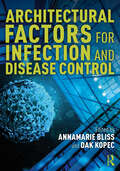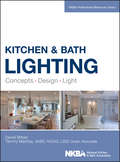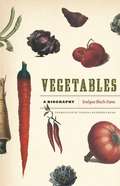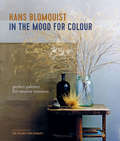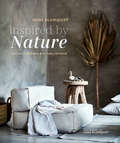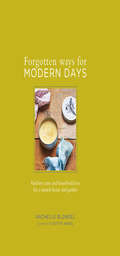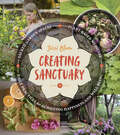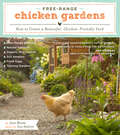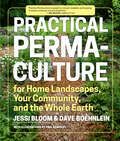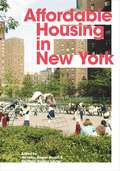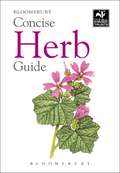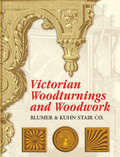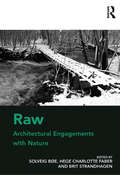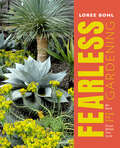- Table View
- List View
Architectural Factors for Infection and Disease Control
by AnnaMarie Bliss Dak KopecThis edited collection explores disease transmission and the ways that the designed environment has promoted or limited its spread. It discusses the many design factors that can be used for infection and disease control through lenses of history, public health, building technology, design, and education.This book calls on designers to consider the role of the built environment as the primary source of bacterial, viral, and fungal transfers through fomites, ventilation systems, and overcrowding and spatial organization. Through 19 original contributions, it provides an array of perspectives to understand how the designed environment may offer a reprieve from disease. The authors build a historical foundation of infection and disease, using examples ranging from lazarettos to leprosy centers to show how the ability to control infection and disease has long been a concern for humanity. The book goes on to discuss disease propagation, putting forth a variety of ideas to control the transmission of pathogens, including environmental design strategies, pedestrian dynamics, and open space. Its final chapters serve as a prospective way forward, focusing on COVID-19 and the built environment in a post-pandemic world.Written for students and academics of architecture, design, and urban planning, this book ignites creative action on the ways to design our built environment differently and more holistically.Please note that research on COVID-19 has exponentially grown since this volume was written in October 2020. References cited reflect the evolving nature of research studies at that time.
Architectural Factors for Infection and Disease Control
by AnnaMarie Bliss Dak KopecThis edited collection explores disease transmission and the ways that the designed environment has promoted or limited its spread. It discusses the many design factors that can be used for infection and disease control through lenses of history, public health, building technology, design, and education.This book calls on designers to consider the role of the built environment as the primary source of bacterial, viral, and fungal transfers through fomites, ventilation systems, and overcrowding and spatial organization. Through 19 original contributions, it provides an array of perspectives to understand how the designed environment may offer a reprieve from disease. The authors build a historical foundation of infection and disease, using examples ranging from lazarettos to leprosy centers to show how the ability to control infection and disease has long been a concern for humanity. The book goes on to discuss disease propagation, putting forth a variety of ideas to control the transmission of pathogens, including environmental design strategies, pedestrian dynamics, and open space. Its final chapters serve as a prospective way forward, focusing on COVID-19 and the built environment in a post-pandemic world.Written for students and academics of architecture, design, and urban planning, this book ignites creative action on the ways to design our built environment differently and more holistically.Please note that research on COVID-19 has exponentially grown since this volume was written in October 2020. References cited reflect the evolving nature of research studies at that time.
Kitchen and Bath Lighting: Concept, Design, Light (NKBA Professional Resource Library)
by Dan Blitzer Tammy Mackay NKBA (National Kitchen and Bath Association)The industry standard illustrated guide from the National Kitchen and Bath Association Co-published by the National Kitchen and Bath Association (NKBA), Kitchen and Bath Lighting is the go-to resource for designing, planning, and installing light in residential kitchen and bath projects. Full color illustrations throughout the book make Kitchen and Bath Lighting a visually absorbing experience. This beautiful volume begins with the basics of light, color, and vision, progressing from there through every stage of the residential lighting design process. With special attention to sustainability and lighting for older eyes, this book contains the information you need to know about the latest trends impacting the lighting industry. Because the NKBA established the standard kitchen and bath guidelines for both new construction and remodels, Kitchen and Bath Lighting is aligned with the practices that are in high demand. This book is also an excellent choice for anyone hoping to obtain credentials as a Certified Kitchen Designer or Certified Bath Designer. Comprehensive coverage of the kitchen and bath lighting process, from the fundamentals of color to design documentation to construction Illustrated guidelines for using lighting tools like sources, luminaries, and controls in design development Glossary and end-of-chapter exercises for quickly learning and referencing key terminology and lighting techniques Companion website offering resources for instructors This new addition to the NKBA's Professional Resource Library is an essential reference for kitchen and bath designers, lighting designers, and interior designers, as well as contractors, retrofitters, specifiers, and anyone else involved in lighting kitchens and bathrooms. Kitchen and Bath Lighting will give you the visual understanding of lighting that can lead directly to client satisfaction.
Kitchen and Bath Lighting: Concept, Design, Light (NKBA Professional Resource Library)
by Dan Blitzer Tammy Mackay NKBA (National Kitchen and Bath Association)The industry standard illustrated guide from the National Kitchen and Bath Association Co-published by the National Kitchen and Bath Association (NKBA), Kitchen and Bath Lighting is the go-to resource for designing, planning, and installing light in residential kitchen and bath projects. Full color illustrations throughout the book make Kitchen and Bath Lighting a visually absorbing experience. This beautiful volume begins with the basics of light, color, and vision, progressing from there through every stage of the residential lighting design process. With special attention to sustainability and lighting for older eyes, this book contains the information you need to know about the latest trends impacting the lighting industry. Because the NKBA established the standard kitchen and bath guidelines for both new construction and remodels, Kitchen and Bath Lighting is aligned with the practices that are in high demand. This book is also an excellent choice for anyone hoping to obtain credentials as a Certified Kitchen Designer or Certified Bath Designer. Comprehensive coverage of the kitchen and bath lighting process, from the fundamentals of color to design documentation to construction Illustrated guidelines for using lighting tools like sources, luminaries, and controls in design development Glossary and end-of-chapter exercises for quickly learning and referencing key terminology and lighting techniques Companion website offering resources for instructors This new addition to the NKBA's Professional Resource Library is an essential reference for kitchen and bath designers, lighting designers, and interior designers, as well as contractors, retrofitters, specifiers, and anyone else involved in lighting kitchens and bathrooms. Kitchen and Bath Lighting will give you the visual understanding of lighting that can lead directly to client satisfaction.
Vegetables: A Biography
by Evelyne Bloch-DanoFrom Michael Pollan to locavores, Whole Foods to farmers' markets, today cooks and foodies alike are paying more attention than ever before to the history of the food they bring into their kitchens—and especially to vegetables. Whether it’s an heirloom tomato, curled cabbage, or succulent squash, from a farmers' market or a backyard plot, the humble vegetable offers more than just nutrition—it also represents a link with long tradition of farming and gardening, nurturing and breeding. In this charming new book, those veggies finally get their due. In capsule biographies of eleven different vegetables—artichokes, beans, chard, cabbage, cardoons, carrots, chili peppers, Jerusalem artichokes, peas, pumpkins, and tomatoes—Evelyne Bloch-Dano explores the world of vegetables in all its facets, from science and agriculture to history, culture, and, of course, cooking. From the importance of peppers in early international trade to the most recent findings in genetics, from the cultural cachet of cabbage to Proust’s devotion to beef-and-carrot stew, to the surprising array of vegetables that preceded the pumpkin as the avatar of All Hallow’s Eve, Bloch-Dano takes readers on a dazzling tour of the fascinating stories behind our daily repasts. Spicing her cornucopia with an eye for anecdote and a ready wit, Bloch-Dano has created a feast that’s sure to satisfy gardeners, chefs, and eaters alike.
Vegetables: A Biography
by Evelyne Bloch-DanoFrom Michael Pollan to locavores, Whole Foods to farmers' markets, today cooks and foodies alike are paying more attention than ever before to the history of the food they bring into their kitchens—and especially to vegetables. Whether it’s an heirloom tomato, curled cabbage, or succulent squash, from a farmers' market or a backyard plot, the humble vegetable offers more than just nutrition—it also represents a link with long tradition of farming and gardening, nurturing and breeding. In this charming new book, those veggies finally get their due. In capsule biographies of eleven different vegetables—artichokes, beans, chard, cabbage, cardoons, carrots, chili peppers, Jerusalem artichokes, peas, pumpkins, and tomatoes—Evelyne Bloch-Dano explores the world of vegetables in all its facets, from science and agriculture to history, culture, and, of course, cooking. From the importance of peppers in early international trade to the most recent findings in genetics, from the cultural cachet of cabbage to Proust’s devotion to beef-and-carrot stew, to the surprising array of vegetables that preceded the pumpkin as the avatar of All Hallow’s Eve, Bloch-Dano takes readers on a dazzling tour of the fascinating stories behind our daily repasts. Spicing her cornucopia with an eye for anecdote and a ready wit, Bloch-Dano has created a feast that’s sure to satisfy gardeners, chefs, and eaters alike.
Vegetables: A Biography
by Evelyne Bloch-DanoFrom Michael Pollan to locavores, Whole Foods to farmers' markets, today cooks and foodies alike are paying more attention than ever before to the history of the food they bring into their kitchens—and especially to vegetables. Whether it’s an heirloom tomato, curled cabbage, or succulent squash, from a farmers' market or a backyard plot, the humble vegetable offers more than just nutrition—it also represents a link with long tradition of farming and gardening, nurturing and breeding. In this charming new book, those veggies finally get their due. In capsule biographies of eleven different vegetables—artichokes, beans, chard, cabbage, cardoons, carrots, chili peppers, Jerusalem artichokes, peas, pumpkins, and tomatoes—Evelyne Bloch-Dano explores the world of vegetables in all its facets, from science and agriculture to history, culture, and, of course, cooking. From the importance of peppers in early international trade to the most recent findings in genetics, from the cultural cachet of cabbage to Proust’s devotion to beef-and-carrot stew, to the surprising array of vegetables that preceded the pumpkin as the avatar of All Hallow’s Eve, Bloch-Dano takes readers on a dazzling tour of the fascinating stories behind our daily repasts. Spicing her cornucopia with an eye for anecdote and a ready wit, Bloch-Dano has created a feast that’s sure to satisfy gardeners, chefs, and eaters alike.
Vegetables: A Biography
by Evelyne Bloch-DanoFrom Michael Pollan to locavores, Whole Foods to farmers' markets, today cooks and foodies alike are paying more attention than ever before to the history of the food they bring into their kitchens—and especially to vegetables. Whether it’s an heirloom tomato, curled cabbage, or succulent squash, from a farmers' market or a backyard plot, the humble vegetable offers more than just nutrition—it also represents a link with long tradition of farming and gardening, nurturing and breeding. In this charming new book, those veggies finally get their due. In capsule biographies of eleven different vegetables—artichokes, beans, chard, cabbage, cardoons, carrots, chili peppers, Jerusalem artichokes, peas, pumpkins, and tomatoes—Evelyne Bloch-Dano explores the world of vegetables in all its facets, from science and agriculture to history, culture, and, of course, cooking. From the importance of peppers in early international trade to the most recent findings in genetics, from the cultural cachet of cabbage to Proust’s devotion to beef-and-carrot stew, to the surprising array of vegetables that preceded the pumpkin as the avatar of All Hallow’s Eve, Bloch-Dano takes readers on a dazzling tour of the fascinating stories behind our daily repasts. Spicing her cornucopia with an eye for anecdote and a ready wit, Bloch-Dano has created a feast that’s sure to satisfy gardeners, chefs, and eaters alike.
Vegetables: A Biography
by Evelyne Bloch-DanoFrom Michael Pollan to locavores, Whole Foods to farmers' markets, today cooks and foodies alike are paying more attention than ever before to the history of the food they bring into their kitchens—and especially to vegetables. Whether it’s an heirloom tomato, curled cabbage, or succulent squash, from a farmers' market or a backyard plot, the humble vegetable offers more than just nutrition—it also represents a link with long tradition of farming and gardening, nurturing and breeding. In this charming new book, those veggies finally get their due. In capsule biographies of eleven different vegetables—artichokes, beans, chard, cabbage, cardoons, carrots, chili peppers, Jerusalem artichokes, peas, pumpkins, and tomatoes—Evelyne Bloch-Dano explores the world of vegetables in all its facets, from science and agriculture to history, culture, and, of course, cooking. From the importance of peppers in early international trade to the most recent findings in genetics, from the cultural cachet of cabbage to Proust’s devotion to beef-and-carrot stew, to the surprising array of vegetables that preceded the pumpkin as the avatar of All Hallow’s Eve, Bloch-Dano takes readers on a dazzling tour of the fascinating stories behind our daily repasts. Spicing her cornucopia with an eye for anecdote and a ready wit, Bloch-Dano has created a feast that’s sure to satisfy gardeners, chefs, and eaters alike.
Vegetables: A Biography
by Evelyne Bloch-DanoFrom Michael Pollan to locavores, Whole Foods to farmers' markets, today cooks and foodies alike are paying more attention than ever before to the history of the food they bring into their kitchens—and especially to vegetables. Whether it’s an heirloom tomato, curled cabbage, or succulent squash, from a farmers' market or a backyard plot, the humble vegetable offers more than just nutrition—it also represents a link with long tradition of farming and gardening, nurturing and breeding. In this charming new book, those veggies finally get their due. In capsule biographies of eleven different vegetables—artichokes, beans, chard, cabbage, cardoons, carrots, chili peppers, Jerusalem artichokes, peas, pumpkins, and tomatoes—Evelyne Bloch-Dano explores the world of vegetables in all its facets, from science and agriculture to history, culture, and, of course, cooking. From the importance of peppers in early international trade to the most recent findings in genetics, from the cultural cachet of cabbage to Proust’s devotion to beef-and-carrot stew, to the surprising array of vegetables that preceded the pumpkin as the avatar of All Hallow’s Eve, Bloch-Dano takes readers on a dazzling tour of the fascinating stories behind our daily repasts. Spicing her cornucopia with an eye for anecdote and a ready wit, Bloch-Dano has created a feast that’s sure to satisfy gardeners, chefs, and eaters alike.
In the Mood for Colour
by Hans BlomquistBring the transformative power of colour into your life with the help of Hans Blomquist, whose inspiring interiors will enable you to find the right colours for your home.
Inspired by Nature: Creating A Personal And Natural Interior
by Hans BlomquistIn Hans Blomquist's new book Inspired by Nature, the stylist and art director identifies the connection between our home environment and our emotional wellbeing.
Forgotten Ways for Modern Days: Kitchen Cures And Household Lore For A Natural Home And Garden Foreward By Dottie Angel
by Rachelle BlondelForgotten Ways for Modern Days draws on the wisdom of the homemakers, gardeners, crafters and kitchen alchemists of the past who kept homes clean, gardens in order and hands busy using natural products and items found close to hand, either around the house or in the garden. Ingredients from kitchen cupboards, picked from the veg patch or foraged from hedgerows were used to clean clothes, cure a chesty cough and freshen the skin, whilst scraps of fabric were recycled in endless useful ways. With sections on Cleaning, Laundry, The Kitchen, In the Garden, Natural Health, and Beauty, Forgotten Ways for Modern Days brings this knowledge up to date and shares with the reader clever tips that make as much sense today, such as how to brighten your whites by putting eggshells in your wash. as well as an array of handy projects, including how to make Re-usable Beeswax Food Wrap, a Honey and Lemon Throat Soother and a Bits and Bobs Eiderdown.
Creating Sanctuary: Sacred Garden Spaces, Plant-Based Medicine, and Daily Practices to Achieve Happiness and Well-Being
by Jessi BloomIn this uplifting guide, bestselling author Jessi Bloom inspires you to turn any outdoor space, from a small balcony to a large garden, into a personal sanctuary for health and wellness.
Free-Range Chicken Gardens: How to Create a Beautiful, Chicken-Friendly Yard
by Jessi BloomIn Free-Range Chicken Garden, Jessie Bloom explains how to have both a happy flock and a beautiful garden, leveraging the soil-building and weed-managing talents of these feathered gardening assistants.
Practical Permaculture: for Home Landscapes, Your Community, and the Whole Earth
by Jessi Bloom Dave BoehnleinCan you imagine a world in which your thriving garden nourishes all of your needs? The first step to building a sustainable ecosystem starts with Practical Permaculture.
Affordable Housing in New York: The People, Places, and Policies That Transformed a City
by Nicholas Dagen Bloom Matthew Gordon LasnerA richly illustrated history of below-market housing in New York, from the 1920s to todayA colorful portrait of the people, places, and policies that have helped make New York City livable, Affordable Housing in New York is a comprehensive, authoritative, and richly illustrated history of the city's public and middle-income housing from the 1920s to today. Plans, models, archival photos, and newly commissioned portraits of buildings and tenants by sociologist and photographer David Schalliol put the efforts of the past century into context, and the book also looks ahead to future prospects for below-market subsidized housing. A dynamic account of an evolving city, Affordable Housing in New York is essential reading for understanding and advancing debates about how to enable future generations to call New York home.
Affordable Housing in New York: The People, Places, and Policies That Transformed a City
by Nicholas Dagen Bloom Matthew Gordon LasnerA richly illustrated history of below-market housing in New York, from the 1920s to todayA colorful portrait of the people, places, and policies that have helped make New York City livable, Affordable Housing in New York is a comprehensive, authoritative, and richly illustrated history of the city's public and middle-income housing from the 1920s to today. Plans, models, archival photos, and newly commissioned portraits of buildings and tenants by sociologist and photographer David Schalliol put the efforts of the past century into context, and the book also looks ahead to future prospects for below-market subsidized housing. A dynamic account of an evolving city, Affordable Housing in New York is essential reading for understanding and advancing debates about how to enable future generations to call New York home.
Concise Herb Guide
by BloomsburyThis beautifully illustrated mini field guide is packed with information on the most common herbs from around the world. Many of these plants grow wild in Britain and other parts of Europe, and can also be cultivated in gardens. The guide additionally includes exotic but commonly used species such as Vanilla, Cloves, Cinnamon and Star-anise.More than 180 herbs are included, all of which are illustrated with superb full-colour artworks that show details of the flowers and leaves, roots and bark where applicable, and growth habit of each plant. A concise written account covering culinary, medicinal and other uses, size, description, habitat and distribution appears on the same page.The easy-to-follow layouts and superb artworks aid quick and accurate identification, making this book an indispensable reference in the field as well as at home. It is compact enough to fit in the pocket, yet packed with essential information. To protect it against the elements in the field, the book is wrapped in a durable plastic wallet. Also included is a fold-out insert with at-a-glance illustrations showing herbs grouped by colour.Renowned natural history artists Christine Hart-Davis, Bridgette James and David Sutton painted the illustrations.
Concise Herb Guide
by BloomsburyThis beautifully illustrated mini field guide is packed with information on the most common herbs from around the world. Many of these plants grow wild in Britain and other parts of Europe, and can also be cultivated in gardens. The guide additionally includes exotic but commonly used species such as Vanilla, Cloves, Cinnamon and Star-anise.More than 180 herbs are included, all of which are illustrated with superb full-colour artworks that show details of the flowers and leaves, roots and bark where applicable, and growth habit of each plant. A concise written account covering culinary, medicinal and other uses, size, description, habitat and distribution appears on the same page.The easy-to-follow layouts and superb artworks aid quick and accurate identification, making this book an indispensable reference in the field as well as at home. It is compact enough to fit in the pocket, yet packed with essential information. To protect it against the elements in the field, the book is wrapped in a durable plastic wallet. Also included is a fold-out insert with at-a-glance illustrations showing herbs grouped by colour.Renowned natural history artists Christine Hart-Davis, Bridgette James and David Sutton painted the illustrations.
Victorian Woodturnings and Woodwork (Dover Architecture)
by Blumer Kuhn Stair Co.Reproduced from a rare original, this 1893 catalog offers nearly 800 detailed and authentic illustrations of superior-quality woodturnings and woodwork. In addition to its conventional examples, it features varied and unusual models of the Victorian style, including stairs, stair railings and balusters, and newel posts; mantels; turned porch and veranda work; gables and window hoods; ventilators; rosettes and other wooden ornaments; and moldings and interior finish.An excellent guide for woodturners and cabinetmakers, this volume also provides an inspiring and instructive resource for architects, preservationists, designers, and students of Victoriana.
Home (PDF)
by Alison Blunt Robyn Dowling'Home' is a significant geographical and social concept. It is not only a three-dimensional structure, a shelter, but it is also a matrix of social relations and has wide symbolic and ideological meanings; home can be feelings of belonging or of alienation; feelings of home can be stretched across the world, connected to a nation or attached to a house; the spaces and imaginaries of home are central to the construction of people's identities. An essential guide to studying home and domesticity, this book locates 'home' within wider traditions of thought. It analyzes different sources, methods and examples in both historical and contemporary contexts; ranging from homes on the American frontier and imperial domesticity in British India, to Australian suburbs, multicultural London, and South Asian diasporic homes. The core argument of the book has three main parts that cut across each of its chapters: home-making identity and belonging homely and unhomely spaces. Each chapter includes text boxes and exercises and is well illustrated with cartoons, line drawings, and photographs. Outlining the social relations shaping, (and being influenced by) the geographies of home; and the imaginative as well as material importance of home, this book will be a valuable reference for students of geography, sociology, gender studies, and those interested in the home and domesticity.
Raw: Architectural Engagements With Nature
by Solveig Bøe Hege Charlotte FaberThrough cross-disciplinary explorations of and engagements with nature as a forming part of architecture, this volume sheds light on the concepts of both nature and architecture. Nature is examined in a raw intermediary state, where it is noticeable as nature, despite, but at the same time through, man’s effort at creating form. This is done by approaching nature from the perspective of architecture, understood, not only as concrete buildings, but as a fundamental human way both of being in, and relating to, the world. Man finds and forms places where life may take place. Consequently, architecture may be understood as ranging from the simple mark on the ground and primitive enclosure, to the contemporary megalopolis. Nature inheres in many aesthetic forms of expression. In architecture, however, nature emerges with a particular power and clarity, which makes architecture a raw kind of art. Even though other forms of art, as well as aesthetic phenomena outside the arts, are addressed, the analogy to architecture will be evident and important. Thus, by using the concept of ’raw’ as a focal point, this book provides new approaches to architecture in a broad sense, as well as other aesthetic and artistic practices, and will be of interest to readers from different fields of the arts and humanities, spanning from philosophy and theology to history of art, architecture and music.
Raw: Architectural Engagements with Nature
by Solveig Bøe Hege Charlotte FaberThrough cross-disciplinary explorations of and engagements with nature as a forming part of architecture, this volume sheds light on the concepts of both nature and architecture. Nature is examined in a raw intermediary state, where it is noticeable as nature, despite, but at the same time through, man’s effort at creating form. This is done by approaching nature from the perspective of architecture, understood, not only as concrete buildings, but as a fundamental human way both of being in, and relating to, the world. Man finds and forms places where life may take place. Consequently, architecture may be understood as ranging from the simple mark on the ground and primitive enclosure, to the contemporary megalopolis. Nature inheres in many aesthetic forms of expression. In architecture, however, nature emerges with a particular power and clarity, which makes architecture a raw kind of art. Even though other forms of art, as well as aesthetic phenomena outside the arts, are addressed, the analogy to architecture will be evident and important. Thus, by using the concept of ’raw’ as a focal point, this book provides new approaches to architecture in a broad sense, as well as other aesthetic and artistic practices, and will be of interest to readers from different fields of the arts and humanities, spanning from philosophy and theology to history of art, architecture and music.
Fearless Gardening: Be Bold, Break the Rules, and Grow What You Love
by Loree BohlFearless Gardening urges home gardeners to be bold, break the rules, and grow what they love.
